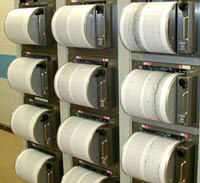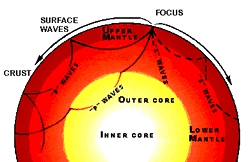BACKGROUND:
 Earthquakes and volcanoes are evidence for plate tectonics. Earthquakes
are caused when energy is released as the lithosphere (crust and upper
mantle) of the Earth moves. Energy is emitted in the form of waves. There
are different types of waves, some move faster, slower, sideways, or up and
down. A seismograph records these waves on a seismogram. When an earthquake
is recorded it is called an earthquake "event."
Earthquakes and volcanoes are evidence for plate tectonics. Earthquakes
are caused when energy is released as the lithosphere (crust and upper
mantle) of the Earth moves. Energy is emitted in the form of waves. There
are different types of waves, some move faster, slower, sideways, or up and
down. A seismograph records these waves on a seismogram. When an earthquake
is recorded it is called an earthquake "event."
There are two types of waves you will discuss with the students, P and S
waves. P waves or primary waves, are the first waves that the seismogram
records. The P wave is the "fast" wave and can be called a
push-pull wave, because it moves by contracting and expanding along a
horizontal path. A P-wave travels through a material as a compressional
force. For example, when you speak, your voice compresses a volume of air.
One of the properties of air (and just about any other material) is that it
resists being compressed into a smaller volume. When your voice compresses
the air, it resists by pushing against neighboring volumes of air. These
volumes then resist compression, and they push back against their neighbors.
This generates a wave of compression that travels through all the volumes of
air between your mouth and the person hearing you.
The second major type of seismic wave is called an S-wave. S-waves are
shear waves. S-waves are slower than P-waves. The particle motion in shear
waves is perpendicular to the direction of the wave.
PROCEDURE:
 Review the divisions of inside the Earth. Earthquakes occur in the
upper part of the crust and mantle. Earthquakes release energy in the
form of waves.
Review the divisions of inside the Earth. Earthquakes occur in the
upper part of the crust and mantle. Earthquakes release energy in the
form of waves.
- Demonstrate P- and S-wave motion to the class. P-waves can be
demonstrated with a slinky. Pull the slinky apart and then pull in about
6 coils. Let them go. The wave will oscillate through the slinky,
alternately compressing and expanding the coils.
- The S wave can be shown by using a rope attached to a wall. Hold onto
the rope and move your wrist up and down. This whipping motion will
generate S-waves. The motion will be up and down as the energy goes
through the rope. Although you can demonstrate both types of wave with a
slinky, we have found that students can distinguish the two types of
waves more readily if you use different materials. If you cannot attach
a rope to your classroom walls, try this demonstration with two people.
- Draw a P and S wave on the board as illustrated below. Make sure the
students understand how to identify them. In addition, explain that the
greater the height of the lines on the seismogram, the larger the
earthquake. This holds true unless a seismograph is located very close
to the epicenter of the earthquake. This causes the wave height to be
exaggerated.